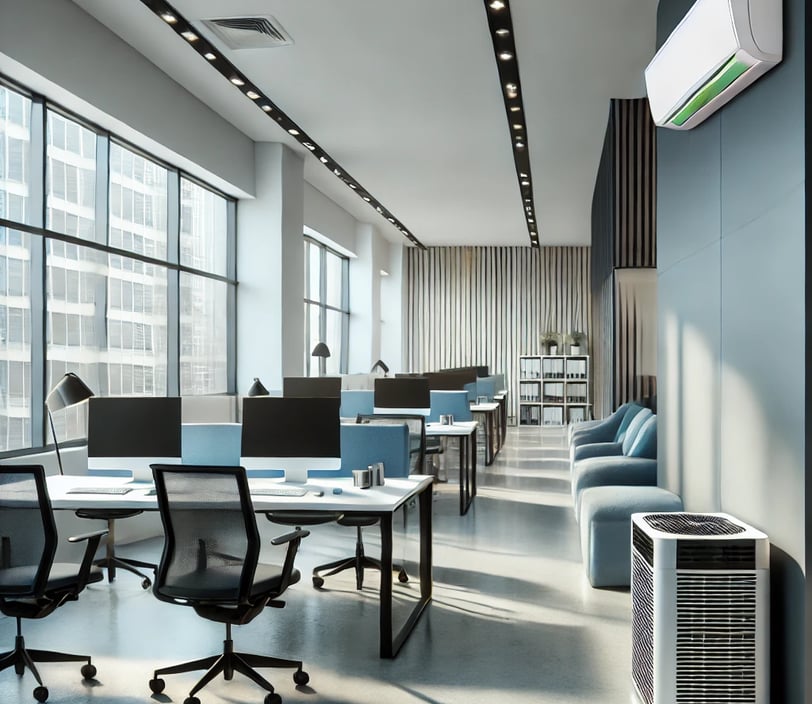Revolutionizing Climate Control: The Future of Air Conditioning with Technological Advancements
2/13/20255 min read


Introduction to Air Conditioning Technology
Air conditioning technology has evolved significantly since its inception, with traditional systems playing a crucial role in indoor climate control. These conventional air conditioning systems primarily rely on refrigerants to absorb heat from the interior of a space and expel it outside, providing a cooler environment. While effective for maintaining comfortable temperatures, these systems often face challenges related to their operational efficiency and environmental impact.
One of the primary concerns with traditional air conditioning units is their high energy consumption. These systems tend to use a substantial amount of electricity, contributing to elevated utility bills and increased demand on power grids, especially during peak summer months. This energy demand is not only costly for consumers but also detrimental to the environment. The majority of electricity generation relies on fossil fuels, leading to higher greenhouse gas emissions that exacerbate climate change. Therefore, the need for more energy-efficient air conditioning technologies has never been more critical.
Moreover, traditional air conditioning systems utilize refrigerants that can be harmful to the atmosphere. Many of these substances have high global warming potentials, which means that their release contributes significantly to the greenhouse effect. As global temperatures rise due to climate change, the dependence on conventional cooling methods only compounds the problem, pushing for the exploration of sustainable alternatives.
Given these challenges, the air conditioning sector is at a pivotal moment where innovation is essential. New technologies are emerging that promise to address the inefficiencies and environmental concerns associated with traditional systems. These advancements aim to create sustainable and efficient solutions for climate control, ensuring that indoor environments remain comfortable while minimizing their ecological footprint. This blog post will delve into these revolutionary technologies reshaping the future of air conditioning.
Understanding the Elastocaloric System
The elastocaloric system represents a groundbreaking advancement in air conditioning technology, developed through innovative research in Hong Kong. At its core, elastocaloric cooling leverages the principles of elastocaloric effect, which involves the thermal response of certain elastic materials when they undergo deformation. When these materials are stretched or compressed, they can absorb or release heat, thereby facilitating a cooling effect without the need for conventional refrigerants.
This system operates through cycles of mechanical deformation. When an elastocaloric material is deformed, it absorbs heat from its surroundings, leading to a reduction in temperature. Conversely, when the material returns to its original shape, it releases the absorbed heat. This unique process allows for a highly efficient cooling mechanism, achieving up to 48% higher efficiency compared to traditional air conditioning systems. Such efficiency can play a crucial role in energy conservation, reducing electricity consumption and greenhouse gas emissions.
Additionally, elastocaloric cooling systems have the potential for diverse applications across various sectors. For instance, they can be utilized in residential air conditioning units, where their compact design and high efficiency make them suitable replacements for conventional units. Moreover, commercial and industrial applications also stand to benefit, particularly in environments requiring precise temperature control, such as data centers and server farms. In some pilot projects, this technology has already begun to demonstrate its effectiveness, showcasing considerable energy savings and improved environmental performance.
The growing interest in elastocaloric systems is indicative of a larger trend towards sustainable technologies in climate control. By reducing reliance on harmful substances and enhancing energy efficiency, the elastocaloric system not only addresses immediate cooling needs but also contributes to long-term sustainability goals. Its development represents a significant step forward in the quest for innovative air conditioning solutions.
Comparative Analysis: Elastocaloric vs. Traditional Systems
In the realm of air conditioning, the elastocaloric system emerges as a promising alternative to conventional methods. Traditional air conditioning systems, widely utilized for decades, typically rely on vapor-compression technology, which involves refrigerants that consume significant energy while contributing to environmental degradation. In contrast, elastocaloric systems leverage the principles of elasticity to actively regulate temperature without the need for harmful refrigerants, promising a more sustainable approach to climate control.
When evaluating energy efficiency, elastocaloric technology showcases substantial advantages. Traditional systems often experience energy inefficiencies due to the fluctuating temperatures they must contend with and mechanical losses during operation. Elastocaloric units, however, function through reversible deformation of materials, operating with higher efficiency levels and potentially reducing overall energy consumption by a noteworthy margin. This efficiency is not only beneficial for the environment but also substantially lowers operational costs.
Environmental impact is another crucial metric for comparison. Conventional air conditioning systems contribute to greenhouse gas emissions primarily through direct refrigerant leakage and high energy usage from fossil-fuel-powered electricity. Conversely, elastocaloric systems emit significantly fewer greenhouse gases and have the potential to be powered by renewable energy sources. This shift contributes positively to global efforts to combat climate change.
From the perspective of user comfort and cost-effectiveness, elastocaloric systems promise a quieter and more compact design, leading to a more pleasant indoor environment. Initial investments in elastocaloric technology can be higher than traditional systems; however, the long-term savings generated from reduced energy bills and maintenance costs present a compelling argument for their adoption. Despite these advantageous attributes, challenges such as the current lack of widespread manufacturing capabilities and the need for enhanced material research limit immediate implementation.
Overall, the transition to elastocaloric air conditioning systems could revolutionize climate control, offering heightened efficiency and sustainability. Addressing existing limitations will be crucial for realizing its full potential in modern air conditioning applications.
Future Perspectives and Conclusion
The landscape of air conditioning is on the cusp of transformation, driven by technological advancements that promise enhanced sustainability and energy efficiency. With the emergence of innovative cooling technologies, such as elastocaloric systems, the future of air conditioning looks not only promising but essential in addressing climate change challenges. These advanced cooling methods hinge on materials that can efficiently absorb and release heat without traditional refrigerants, showcasing potential for a significant reduction in carbon footprints associated with conventional air conditioning systems.
Future perspectives on air conditioning indicate an increasing focus on integrating smart technology, which will enable systems to adapt in real-time to changes in environmental conditions. This development allows for more precise temperature control, leading to further energy savings and improved comfort. Additionally, ongoing research into alternative cooling technologies, such as thermoelectric cooling and solar-powered air conditioning, holds great potential to revolutionize the industry. These innovations can drastically reduce reliance on energy sources that contribute to climate change, ultimately promoting a more sustainable future.
As we look ahead, it is crucial for consumers, businesses, and policymakers to adopt these innovative cooling technologies. The drive towards energy-efficient solutions not only mitigates the adverse effects of global warming but also encourages economic savings through lower operating costs. Staying informed about the latest advancements in cooling technologies will empower individuals to make informed choices about their air conditioning needs.
In conclusion, the future of air conditioning is bright with possibilities stemming from the intersection of technology and sustainability. Embracing these advancements will benefit not only the environment but also enhance energy efficiency in homes and businesses. As we navigate this changing climate, it is imperative to support and implement newer cooling technologies that align with a commitment to a sustainable future.
